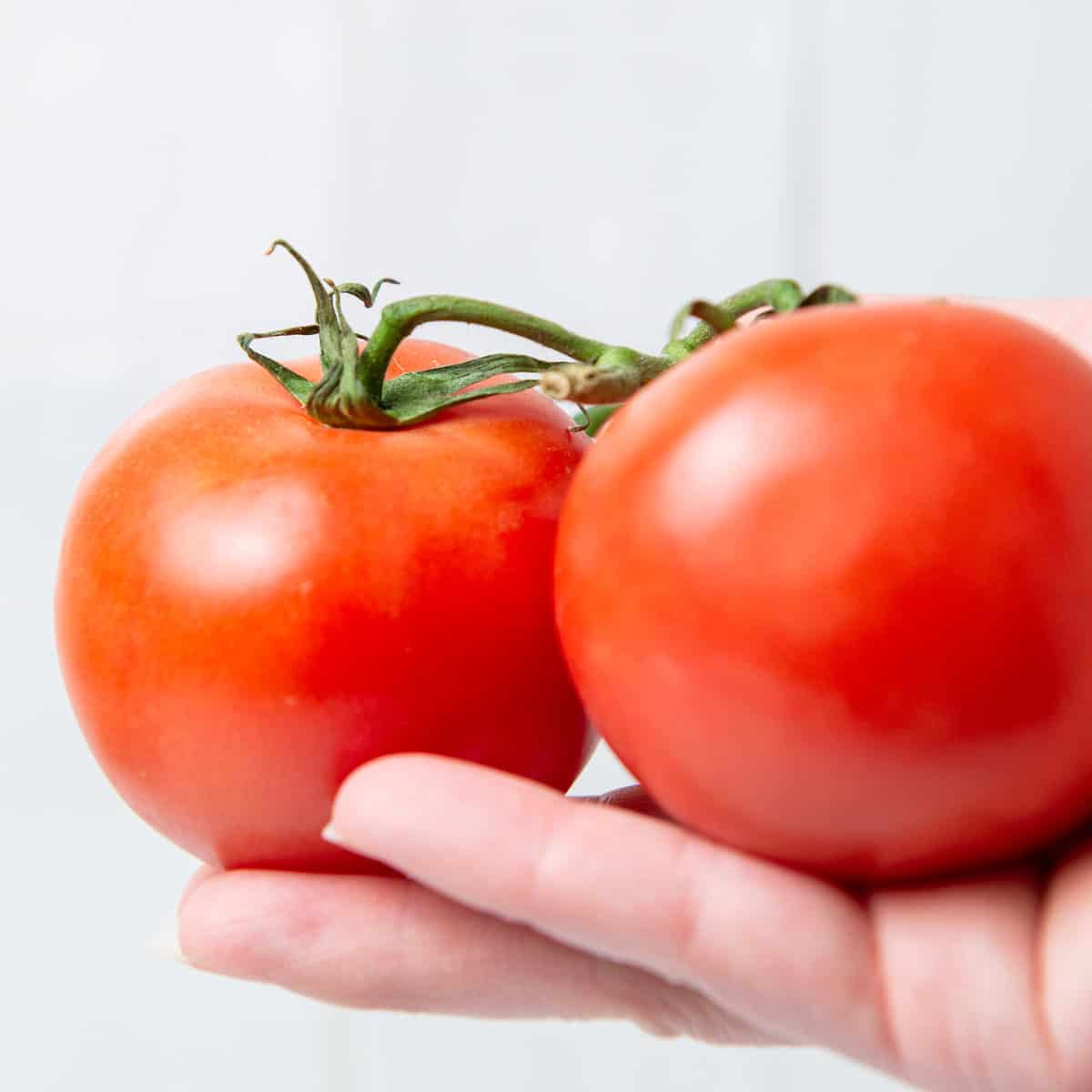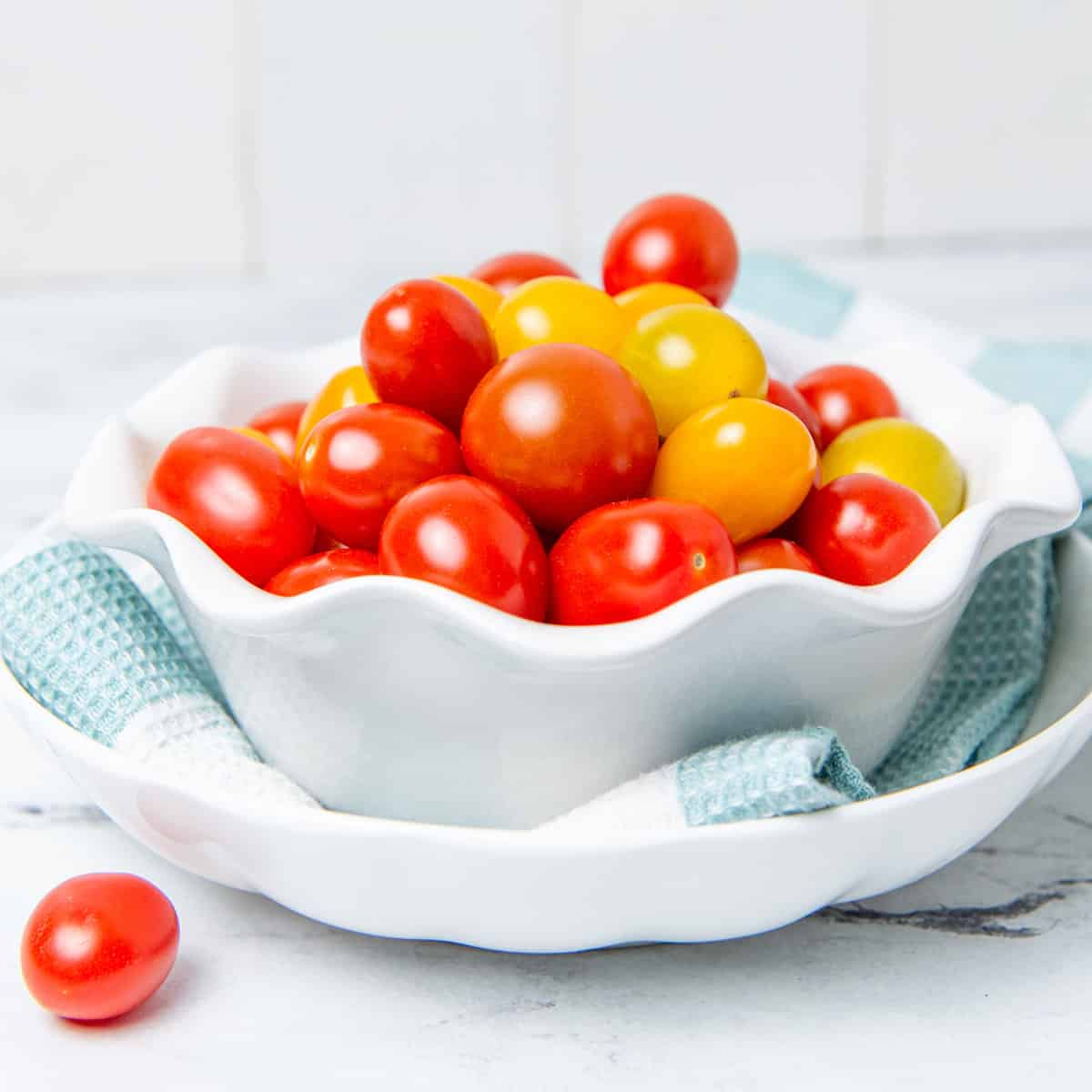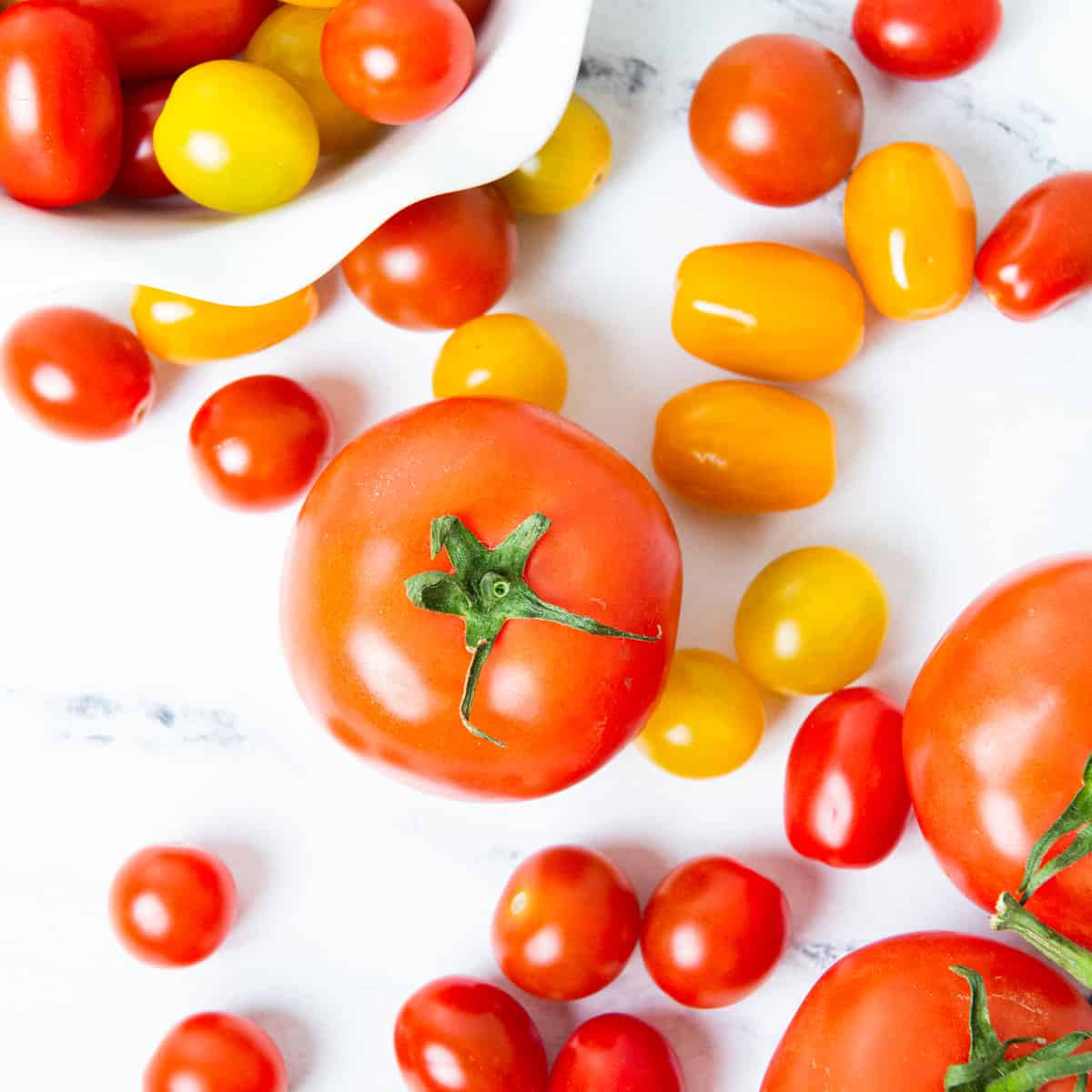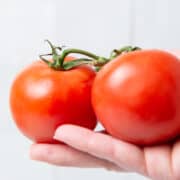Tomatoes are a popular addition to so many recipes. Whether you're making tomato sauce, pasta with cherry tomatoes, a dipping sauce for appetizers, or another dish using this delicious ingredient, it's important to know how to store tomatoes to keep them fresh.

Jump to:
You can find tomatoes (which are technically a fruit and not a vegetable) at most grocery stores and markets and some people like to grow their own fresh tomatoes. I've grown them and they're an easy crop to grow, even if you're not especially green-fingered!
Tomatoes come in different varieties and you probably know some of the most common ones, including cherry or baby tomatoes, green tomatoes (great for frying!), plum or Roma tomatoes, and big beefsteak tomatoes (great for stuffing!)
I often use fresh tomatoes in summer salads because they go so well with other salad vegetables and add a nice pop of color to the dish. One of my favorites is Caprese salad - a mouthwatering blend of tomatoes, mozzarella, and fresh basil with a balsamic vinaigrette. It's so good!
What are Tomatoes?
The first tomatoes (Solanum Lucopersicum) grew in Mexico, Central America, and South America. It is believed that the tomatoes eaten by the Aztecs also found favor with Spanish conquistadores who then introduced the fruit into Europe in the 1500s.
Tomatoes are versatile enough to be used in both sweet and savory recipes. They can be used to make snacks, beverages, salads, soups, breakfast dishes, and so much more. I once tried a tomato cheesecake on vacation which might sound weird, but the sweetness of the tomatoes was so good - it was very similar to a soft fruit-topped cheesecake with a slightly more unusual flavor.
Tomatoes contain Vitamins C and K, folate, and potassium. Although red tomatoes are probably the first ones you think about, this fruit also comes in orange, yellow, purple, and green, and there are many subspecies too. Different varieties vary in sweetness, tartness, skin thickness, and more. Tomatoes are 95% water and 5% fiber and carbs.
How to Shop for the Best Tomatoes
It's useful to know that tomatoes grown commercially are typically transported before being ripe, and then they're sprayed with ethylene gas to speed up the ripening process and make them red. As this unripe tomato process can inhibit the rich tomato taste, I'd recommend choosing locally grown tomatoes from the farmer's market or an organic grocery store.
Even if they're not ripe yet, you can wrap a paper towel around unripe tomatoes and leave them at room temperature for a few days to ripen then naturally. If I do this, I put them on the kitchen windowsill and the warmth and light encourage them to ripen. Direct sunlight can also speed up the tomato ripening process. The best quality tomatoes are those you can smell through the skin. If you can smell them, they will have the best flavor.
Buy tomatoes that are smooth, shiny, and red (or the correct color depending on variety) all over. Avoid any with pale or hard areas near the stalk and those with cracks or bruises. Tomatoes that have green or yellow patches were ripened off the vine, which makes shipping easier, but also makes the flavor blander, even if you finish ripening them at home. With tomatoes, I find the farmers' market ones so much tastier and don't mind paying a little extra.

How to Store Tomatoes
Whether you are looking for the best way to store cut tomatoes or whole tomatoes, these are the best tips to help avoid them spoiling too fast or developing a mealy texture.
- Whole tomatoes should be stored away from direct sunlight, in the fridge, as they like cold temperatures. The exception to this would be unripe tomatoes, which should be kept wrapped in a paper towel and kept at room temperature to fully ripen. Unripe tomatoes won't ripen if kept in the refrigerator. If they're overripe, use them as soon as possible for tomato sauce, relishes, and so on.
- Cut tomatoes don't have the skin to protect the flesh, but you can still store tomato leftovers. Cover the cut part with plastic wrap or in a small plastic bag, and keep the tomato cut side facing down on a saucer in the fridge. If you have tomato slices (such as the slices you'd put on a burger) keep them refrigerated in an airtight container. I usually put paper towels under the tomato slices to soak up excess juice.
Whole tomatoes at peak ripeness should last up to 2 weeks, a partially used tomato should keep for several days, and the shelf life of tomato slices is 2 or 3 days, but they'll be better eaten the next day. Rinse them under cold water before use.
Another option is to freeze tomatoes, which is a great way to keep them for longer if you find yourself with too many to use. Discard the stalks and freeze the tomatoes in a freezer-safe bag or airtight container for up to 6 months.
How to Tell if Tomatoes are Spoiled
A rotten tomato is going to leak out juices, so if there's fluid underneath your tomato, it's spoiled. If it's mushy or soft or has a putrid or bitter smell, it's rotten. A tomato that's a bit soft in places or slightly wrinkled can still be used to make tomato paste, tomato sauce, or soup, but if it's in a worse state than that, it's best to throw it out, especially if you have tomato slices which have gone slimy.
Common Questions
If there are patchy bruises or patchy soft spots, it should be fine to trim off and discard those, as long as the rest of the tomato is in a good condition. However, if most of the fruit is bruised or mushy, you should toss it out.
Whether you're growing your own or you buy some that aren't quite ripe, you might be wondering how to ensure you end up with juicy tomatoes that have a sweet flavor and are perfectly ripe and delicious. The best temperature for this would be between 68°F and 77°F, which is the typical room temperature in many households. They will also ripen at colder temperatures, but will just take longer to do so.
Regardless of the size of the tomatoes, the same general rule of thumb about storage applies. Whether you have plum tomatoes, Roma tomatoes, grape tomatoes, or heirloom tomatoes, follow the above tips to keep them fresh and delicious until you're ready to use them.

Fun Facts
- Heinz tomato ketchup has a speed limit - yes, really! If it pours out of the bottle faster than 0.028mph, it's rejected for not being thick enough.
- There are more than 10,000 tomato varieties in the world.
- La Tomatina is a Spanish festival in which people throw about 150,000 tomatoes at one another.
Knowing how to store tomatoes the easy way means you can keep them fresh and delicious, whether you're enjoying this produce from farmers' markets, growing your own, or even using supermarket tomatoes.
Tomatoes can be enjoyed as they are or made into some serious eats such as salads, soups, and sauces. Tomatoes are versatile enough to make literally hundreds of different dishes and most people enjoy the flavor, so it's definitely worth discovering how to keep them fresh for longer.














